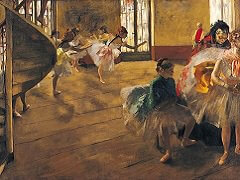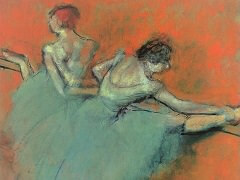The False Start, 1860 by Edgar Degas

Edgar Degas had been the first among the Impressionist group to paint scenes of the race course. In the early sixties he had found possibilities of action in the nervous high-bred horses, and color in the gay suits of the jockeys. Many drawings and little sculptured models of race horses were laid up in his studio, and from these he developed his finished paintings on the theme, not unaware of English racing pictures and also of those canvases done at Epsom Downs by Gericault, the great Romantic painter in the 1820's.
This early treatment of the subject is carefully planned with large areas of flat, rather restrained color and carefully realized silhouettes of the horses and riders. By pushing the running horse and grandstand to the left of his canvas he was able to suggest space into which they seem about to move. In the background he blurred the watching crowd, scattering little notes of bines, salmon, rose, and moss-green, lending animation to the scene and contrasting with the broader passages of tans, browns, and blacks. Always sensitive to light, the painter floods his picture with the cool outdoor illumination of Paris. Shadows are kept at a minimum and the whole scene united by that exquisite scale of values which Degas employed at this period.
















